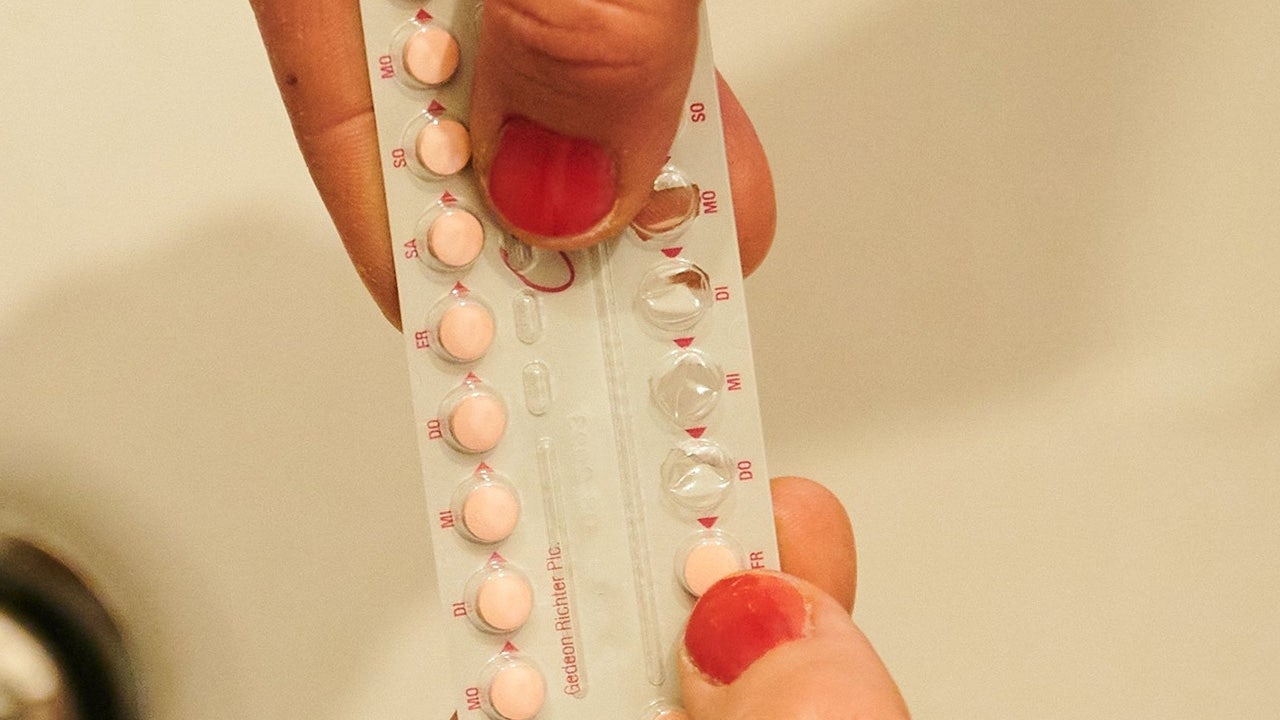Lifestyle
With a new jewelry line, Aleali May is designing mini monuments to the self

Aleali May loves an Easter egg. And at Paris Fashion Week last year, it was unmissable: a giant, gleaming butterfly hanging above her solar plexus at the Louis Vuitton men’s show by Pharrell Williams. A butterfly is known for its transformative qualities, is symbolic for its hero’s journey — starting as one thing and going through pain and darkness to come out the other side something bigger and more beautiful. The piece is part of a collection, which May designed as the first drop from lab-grown diamond company GRWN, called Metamorphosis. “[It’s] me evolving in the space of jewelry, and me just evolving, honestly,” the creative director and designer says. “This is a moment.”
An obvious centerpiece of the Metamorphosis collection is a choker with a line of three large butterflies dropping down toward the belly button, the last and largest being the size of a child’s hand and positioned at an angle — every inch of the piece decked out in lab-grown diamonds. There is also a smaller necklace that is no less ornate or extravagant: a large butterfly hanging at the tip of one of its wings from a cartoonishly large cable chain worn close to the clavicle. A bracelet is designed in the same vein, featuring a similar large cable chain with blueberry-sized butterfly charms dangling from it. There is a ring that takes up half the space of a finger, going past the knuckle with small butterflies flying throughout its frame. The collection has eight pieces total, including necklaces, hoops, studs, rings, bracelets and lariats, set in sterling silver and recycled 18-karat gold.
Aleali May is the creative director behind a new lab-grown diamond company, GRWN. “[It’s] me evolving in the space of jewelry, and me just evolving, honestly,” she says of her first collection, called Metamorphosis. “This is a moment.”
“Growing up as a young kid of color, hip-hop raised me. I’m thinking gaudy. I’m also thinking simple.”
— Aleali May
May wanted the pieces to feel nostalgic and, essentially, for the girls. She called upon her fashion foremothers — Foxy Brown, Lil’ Kim — taking inspiration from music videos of the late ’90s and early 2000s. Back then, more was more. “Quiet luxury” wasn’t a phrase in our popular consciousness yet — it was all about the drip. “Growing up as a young kid of color, hip-hop raised me,” May says. “I’m thinking gaudy. I’m also thinking simple.”
May tapped her streetwear background to bring a collaborative energy to GRWN. At this point, she’d not only been the architect of her own looks for years — from her days working at iconic concept shop RSVP Gallery in Chicago to 424 on Fairfax — she’d also made streetwear history, becoming the first woman to design a unisex sneaker with Jordan and only the second woman to ever design a sneaker with the brand. Over the last few years, she also started her own line of basics, called Mayde, and collaborated on collections with major brands including Vanson Leathers and Clarks, in addition to working with Sheron Barber Atelier on a collection of diamond-shaped purses, plus a line with jewelry designer Martine Ali.
In her first meeting with the founders of GRWN, father and son Michael and Jordan Pollak, May remembers asking for a sign from the universe. The fact that their first names combined were “Michael Jordan’’ was a detail that was not lost on her. In her conversations with the brand, May felt like these were people who wanted to “build the youth.” It was evoking the education she received while working with Don C and Virgil Abloh at RSVP Gallery, about presenting luxury in a new way. She was interested in the sustainability aspect, and the fact that it was a luxury brand that wanted to connect with people investing in their first major piece of jewelry resonated. (Lab-grown diamonds are a fraction of the price of mined diamonds and, according to the International Gem Society, have less negative impact on the environment. The pieces in the Metamorphosis collection range from $525 to $5000.) The brand’s first collaboration, coming in June, is with online men’s fashion retailer MAD. And though May is tight-lipped about who GRWN will be working with the rest of the year, she says its collaborators are “very much like ourselves: disruptors in a very old industry.”
May’s creative process when designing a necklace or a ring isn’t that different from designing a sneaker — at least not energetically. It all boils down to the unfolding of a narrative. She brings up her Air Jordan 14 Retro Low SP “Fortune” shoe, in which the gold and jade elements were inspired by the first piece of jewelry given to her by her Fillipina grandmother when she was growing up. The shoes feature an all-over sandy suede, with gold and jade accents on the shank plate and outsole. “The story behind the [Air Jordan] 14 is that [the silhouette and design is] based off of Ferrari. Men, when they think of luxury, it’s riding a car. What’s luxe for women? Usually jewelry,” says May.
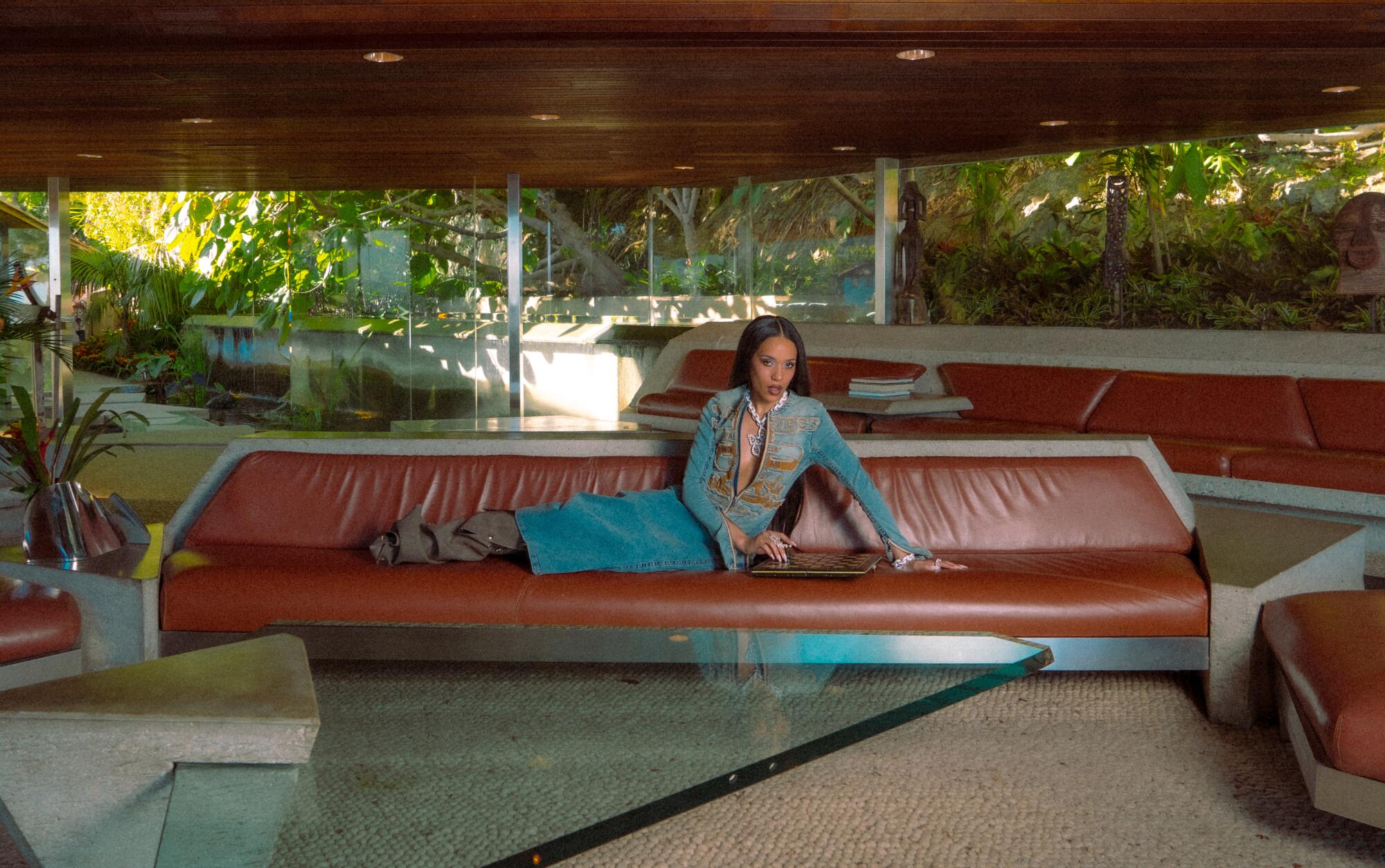
May wears Y/Project dress and shoes and GRWN accessories.
There was an episode of May’s now-defunct web series for Complex, “Get It Together,” where the designer goes to Slauson Super Mall with designer Melody Ehsani. In one scene, she and Ehsani look out over the glass at the iconic L.A. Gold stall, and May paraphrases a quote from one of her favorites, Pimp C, in his intro to the Jay-Z and Rick Ross song “F*ckwithmeyouknowigotit”: “We love these things because we used to be kings and queens.” She’s referring to the glowing gold in the display. To a young Black girl in L.A., this was luxury. To shine not only felt essential, but it was tradition. There are specific pieces May has been wearing for years that we’ve all come to recognize, like the gold Rolex chain with the “A” at the center, made by her jeweler James V Ta in Chinatown. “Being from South Central, if you know ’hood politics, you know that a Rolex chain represents something,” she says.
Working with the GRWN team, May wanted the pieces to be reflective of her and her people — the way her contemporaries shop, the way they accessorize, the way they move were all important considerations in the process. “Growing up in L.A., we always would have stuff from the swap meet,” says Tyler Adams, May’s longtime friend and collaborator turned manager. “That’s just kind of a rite of passage here. You get your name plates, or bamboos, or rings. You’ll get things passed down from your grandparents or your mom or your dad. But she’s always had a crazy jewelry stack. She was wearing the Hermès Clic Clac H bracelets when we were mobbing around, the Cartier Love bracelets. You figured out what jobs you had to do, how you could trade up and get these kinds of things. With [the] culture and industry that we work in, you move into cooler diamond pieces, but she’s always had a jewelry thing.”
Over time, jewelry becomes part of our bodies, like the mole that mysteriously appeared on your chest in your early 30s. I haven’t taken my white gold “JUJU” nameplate off since the day I got it, years and years ago. I can’t imagine a day when I won’t shower with it, go to the gym with it or sleep with it. It’s become part of my identity, a physical feature that’s as illustrative of my essence as my curly hair. A piece of jewelry, when worn especially close, tells our story for us. You know someone’s name, relationship status, religious affiliation and neighborhood or origin from the letters on their nameplate, which finger their ring sits on or the style of chain sandwiched between their necklines. No words necessary.
In May’s first collection for GRWN, you can see a reflection of where the designer is now. “And obviously I was like, let’s get icy,” she says.

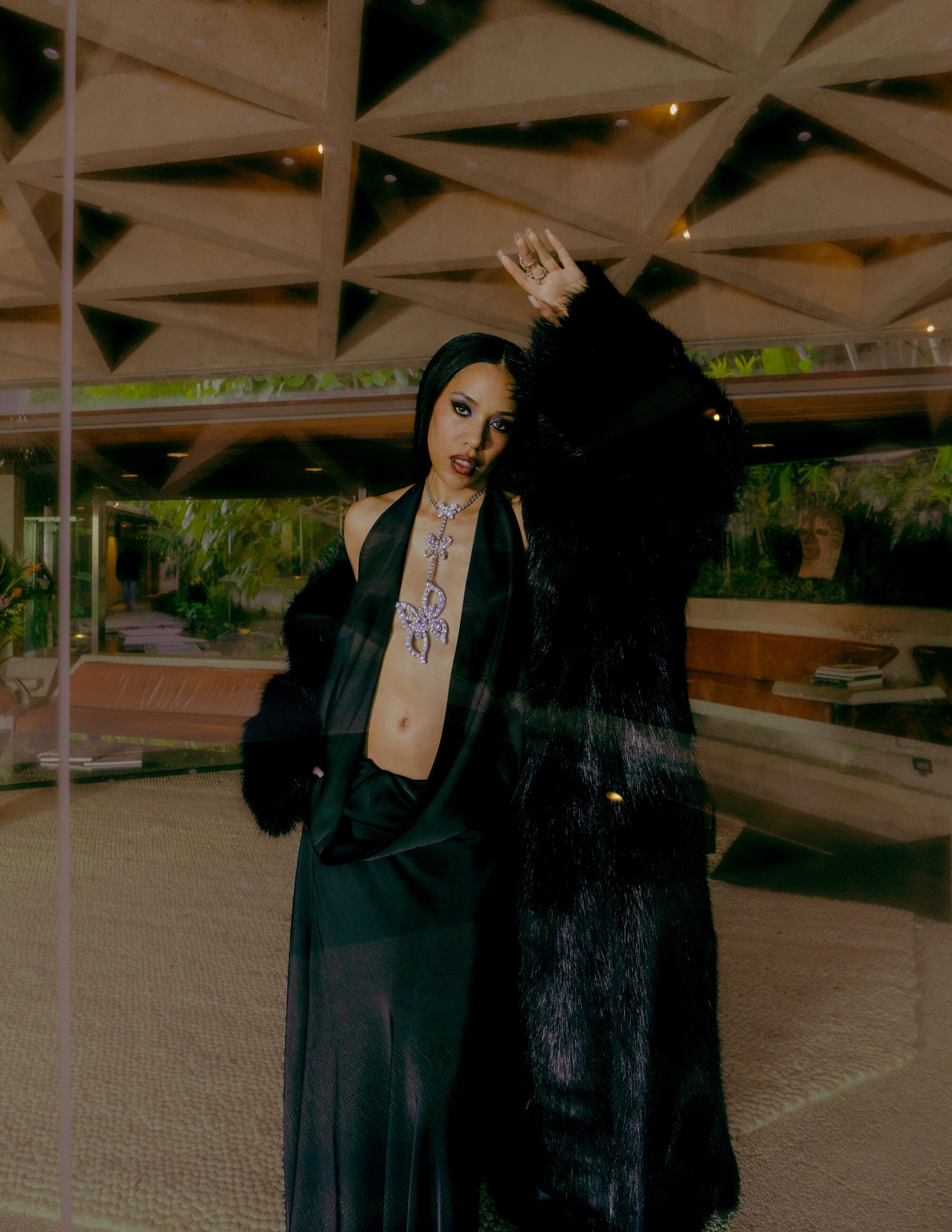
May tends to design things we live in and identify with — sneakers, leather jackets and, now, jewelry.
We’re sitting in the lobby of the 1 Hotel in West Hollywood when I ask Aleali May about her Saturn return. There is a constant hum of people typing on their computers around us while men wearing baseball caps, joggers and long-cut thin cotton tees (the outfit version of a Tesla) pace in circles taking business calls. When May descended the staircase 20 minutes earlier, there was a noticeable vibe shift. She was the only one wearing three different shades of black, Balenciaga Crocs, a Louis Vuitton bag and a Harley Davidson bandanna on top of her waist-length black hair. There is a glint of recognition in her eye when I bring up Saturn. “Mind you, yesterday my home girl was like, ‘Did you get yours?’” A Saturn return is an astrological event that happens when you’re between 27 and 32 years old, when you go through turbulent transformations in your personal life that take you to your breaking point; a time when you’re forced to get real about your needs and desires. May, a Cancer, turns 32 this summer. “Girl. Hm. Yeah. Jeez,” she grunts, as if realizing something. “I’m still evolving every single day. But when I hit 28 is when that shift really started happening for me.”
The shift May is referring to is the one where she began to fully distinguish herself as a designer — not a designer-slash-anything. The South Central native became recognized for her personal style, documented famously on Tumblr and then Instagram. Her look was a mix of streetwear and femme luxury, hundreds of pairs of Jordans and heeled boots sitting side by side in her closet. She once described it to Farfetch as “a mix between streetwear and high-end fashion mixed with ’90s hip-hop/R&B and vampire avant-garde.” Styling jobs would soon follow, for clients including Kendrick Lamar, Lil Yachty, Jaden Smith and Kali Uchis. Modeling jobs came organically (May has a kind of preternatural beauty, and it was her childhood dream to become a model, second only to becoming a fashion designer). She’d also designed some of the most talked-about sneakers in recent memory. Her shoes, a total of five with Jordan, are known for selling out in minutes, and she famously leaned into color, faux fur, texture and print. SSENSE dubbed her the queen of sneakers.
But May’s innate demeanor — one that doesn’t reach too hard but instead sits back and lets people catch up on their own, mostly born out of inherent shyness — oozes with a casual influence, which led the internet and industry to dub her an influencer. It’s a label that’s been hard to shake for May, showing up in articles and on call sheets next to her name for years. “I’ve constantly had to remind people that what I love, what I do, is fashion,” May says. “I am a designer, and I got some ideas.”
May also was 28 when she got the call from GRWN, the timing of which feels significant in retrospect. She had recently made the decision to retire from styling, and called her agency to let them know that she didn’t want to make posts about bags anymore; she wanted to be the one designing the bags.
In her design work, May draws on personal history and L.A. lore. The context clues are familiar, allowing us to recognize something kindred in the details. These are stories and references that we all know but for the first time are experiencing in a package like this one. Her first sneaker, the Air Jordan 1 Retro High OG “Satin Shadow,” infused elements of the L.A. uniform she saw around her growing up, while roping in the things that make up May’s style now: satin inspired by a vintage Raiders or L.A. Kings Starter jacket, the ribbed corduroy from the house shoes her dad would buy at the swap meet, a quilted inside that draws from the iconographic element of a Chanel bag. “I’ve seen her grow in design far beyond colorways or materials, but actual storytelling,” says Frank Cooke, a curator and former Jordan designer who worked with May on her sneaker collaborations. “I think that that’s one thing that kind of separates her from a lot of different collaborators is that she always tries to tell a story.”
The pieces are anchored in the autobiographical. They also lean toward the structural. May tends to design things we live in and identify with — sneakers, leather jackets and, now, jewelry. Her pieces all become mini monuments on their own, but on the body operate like an addition to a house.

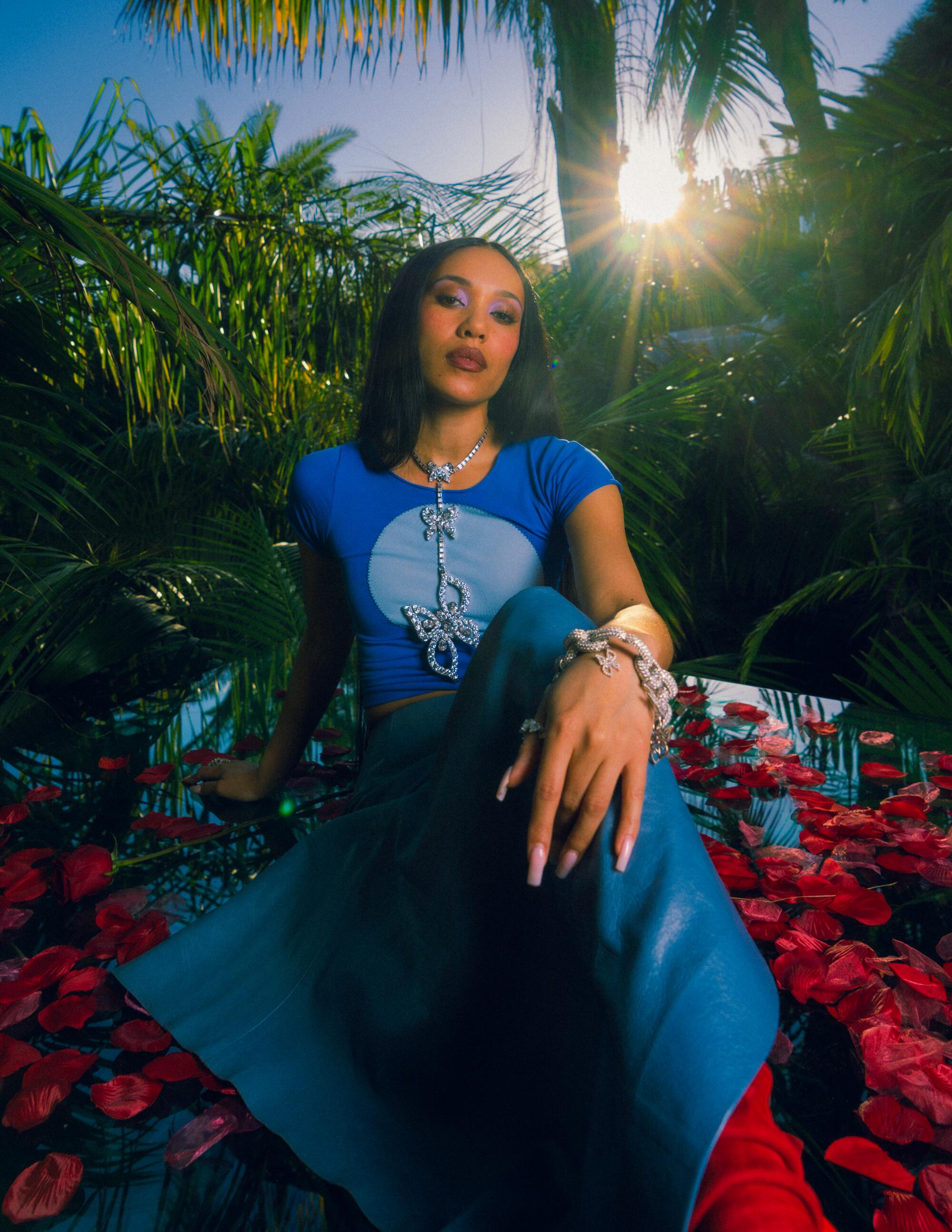
May wears Marni top, bottom, and shoes, with GRWN accessories.
People never seem to recognize this, but May is low-key goth. She speaks with a South Central-inflected monotone in her voice, and is always down to lean into the darker undertones of an outfit, upping the drama with black leather or structural details. She had a goth aunt growing up; she still thinks about her sometimes when constructing a look for the day. “She was the black lipstick, black T-shirt, Doc Martens girl with the glow-in-the-dark nail polish,” May remembers. “Korn posters, Slipknot. When I’m looking at all the people in my life growing up, they all had their own personal style.” This alternative streak lends itself to her designs. Her sneakers attract the type of wearer who is not only comfortable with being different but thrives in it — rocking a dusty rose suede contrasted against a streak of orange in her Air Jordan 6 Retro “Millennial Pinks.” We get the rebellious sense from her pieces that they don’t care whether you understand them .
In 2021, she collaborated with Mattel on an Aleali May Barbie for private auction. An ode to her multitude of designs, the doll was replete with mini re-creations of her “A” chain, a sample leather two-piece set from her personal line, the first shoe she made with Jordan and a bag from the collaboration she did with Martine Ali.
The Harley-Davidson bandanna she’s wearing at the 1 Hotel was inspired by
her father, who goes by Buddha, and is president of the motorcycle club Chosen
Few’s Colorado chapter and was a former member of the Ruff Ryders. May was
influenced by him when designing her collection with Vanson Leathers and Fly
Geenius. She’s always drawing from the root. Her family, her Black and Filipina
background, her pop culture references as a teenager, growing up in L.A., her time in Chicago — they all factor into the personal style and design approach that’s earned her nearly half a million Instagram followers. Every day, a new May. “I am a girl that likes to switch up,” she says. “I might be super goth today, but tomorrow I could be a hipster wearing tie-dye like I need to be walking in Malibu with a denim bucket hat. I like to have different types of jewelry for different occasions and obviously, I’m always putting on an outfit.”
She’s spotted at show after show, often in the front row. Gucci, Louis Vuitton, Rick Owens. Ottolinger, Mugler, Sacai, Balmain, Givenchy, Chanel. Following May along her various fashion week journeys is a good way to gauge what she’s working on, and in the last year, we’ve seen the Metamorphosis collection in almost every public appearance, even if we didn’t know what it was yet. “Need this necklace,” the Instagram comments inquired. “I was at the Gucci show in Milan, and one of the photographers was like, ‘Is that a collab you’re working on? Because we don’t see you pop out like that,’” May remembers. “I’m glad you get the hint. I mean, it is big. You can’t miss it.”
The butterfly is a classic motif in jewelry. Has been for centuries. GRWN’s director of design, Annalisa Cervi, brings up Wallace Chan, a Hong Kong jeweler and visual artist known for his intricate carvings from gemstones that often feature butterflies. In classical jewelry design, the butterfly often is used to communicate an appreciation for Mother Nature, Cervi explains, reflected in its natural cycles and rhythms. In this case, the butterfly was personal to May’s story. In immortalizing it in stone forever, there was an acceptance that once she stepped into this new role, there was no going back to what was.
Butterflies, when spotted in the wild, or tattooed on the torsos of chaotic girls in their 20s, may be regarded as some kind of a sign. We designate a spiritual meaning to these creatures, seeing them as a nod from the ether that it’s time for a change or, better yet, growth. And even more obvious than the meaning behind it is the collection’s flashiness, which forces the wearer to ascend, or move differently. The Metamorphosis Butterfly Diamond Pendant in particular might blind someone on a sunny day. It would call attention on anyone but even more so on May, who pairs it with Rick Owens shoulders, pink leathers, fur hats and full camo fits. “She’s naturally evolving,” May says. “And you’re seeing that.”
A point often pushed by the lab-grown diamond industry is that the stones have the exact same chemical composition as mined diamonds. With mined diamonds, the clarity is up to chance; whether a single 1-carat diamond might be found within 200 million pounds of ore is a gamble. In May’s case, the clarity she was looking for was one she had to grow herself.
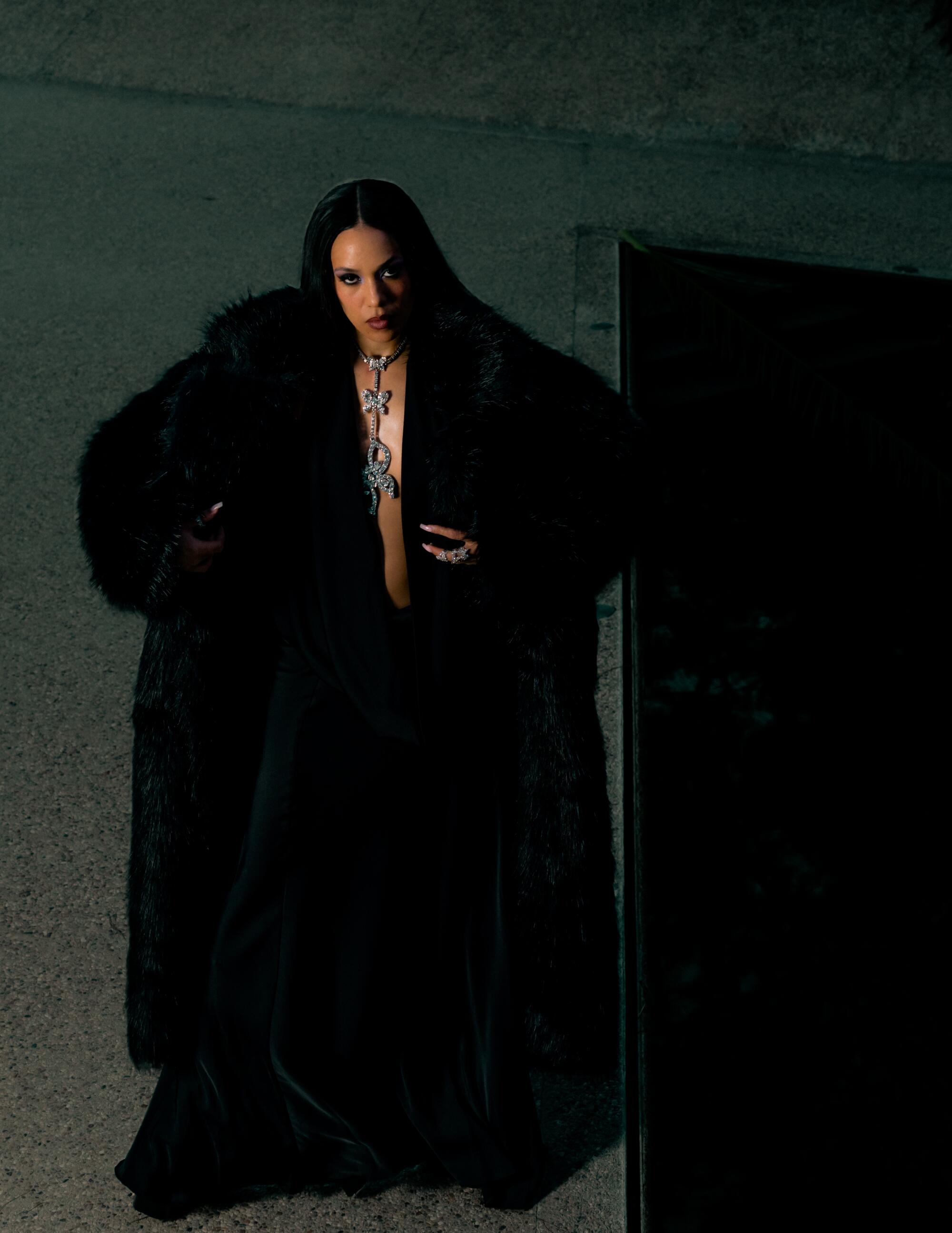
In her design work, May draws on personal history and L.A. lore. The context clues are familiar, allowing us to recognize something kindred in the details.
(Tumi Adeleye)
Production: Mere Studios
Makeup: Laura Dudley
Hair: Adrian Arredondo
Photo Assistant: Qurissy Lopez
Location: Sheats–Goldstein Residence

Lifestyle
'Wait Wait' for July 27, 2024: With Not My Job guest Kathleen Hanna

Kathleen Hanna of The Julie Ruin performs onstage at the 2016 Panorama NYC Festival – Day 2 at Randall’s Island on July 23, 2016 in New York City. (Photo by Nicholas Hunt/Getty Images)
Nicholas Hunt/Getty Images/Getty Images North America
hide caption
toggle caption
Nicholas Hunt/Getty Images/Getty Images North America
This week’s show was recorded in Chicago with host Peter Sagal, judge and scorekeeper Bill Kurtis, Not My Job guest Kathleen Hanna and panelists Meredith Scardino, Peter Grosz, and Mo Rocca Click the audio link above to hear the whole show.
Who’s Bill This Time
Momala Takes Over; Assigned Seats Are Back; And The Heat Is On
The Olympic Torch Reporch
Our Summer Olympics Preview
Bluff The Listener
Our panelists tell three stories about someone committing an office faux pas, only one of which is true.
Not My Job: We quiz Bikini Kill’s Kathleen Hanna on Hanna-Barbera
Punk icon Kathleen Hanna plays our game called, “Kathleen Hanna Meet Hannah-Barbera.” Three questions about the animation studio.
Panel Questions
Hide Your Receipts; VR Meets ER; Avocado Apologies
Limericks
Bill Kurtis reads three news-related limericks: Situation Room Cocktails; Burrito Bird; Hopped Up Sharks
Lightning Fill In The Blank
All the news we couldn’t fit anywhere else
Predictions
Our panelists predict what will be the big story out of the Paris Olympic Games
Lifestyle
L.A. Affairs: At 77, I had a crush on my best friend’s widower. Did he feel the same way?

At 77, I had given up. After two failed marriages and years of unsuccessful dating, I accepted what seemed to be my fate: single for almost 40 years and single for however many remained. You don’t get it all, I told myself. I was grateful for family, friends and work. Life settled into what felt like order.
Until Ty.
As the husband of my best friend, he was no stranger, but he was usually peripheral. Then 10 years ago, my friend got lung cancer. I watched during visits, stunned at how nurturing Ty could be, taking care of her even though they had separated years before at her request.
After she died, Ty and I stayed in touch sporadically: a surprise sharing of his second granddaughter a year after we scattered my friend’s ashes, an invitation to the launch of my book a year later. Ty attended, hovering in the back, emerging after everyone left to attentively help load my car.
Two more years passed. During quiet moments, I remembered his sweetness. I also remembered his handsome face and long, tall body. Confused about what I wanted, I texted Ty, who’s an architect, under the guise of purchasing a tree for my backyard.
We spent an afternoon at the nursery, laughing, comparing options and agreeing on a final selection. When the tree arrived, I emailed a photo. He emailed a thank you.
Another three years passed, broken only by news of his third granddaughter and my memories of how good it felt to be with him. Alert to his attentiveness, but unsettled by both his remove and my growing interest, I risked reaching out again, this time about remodeling my garage.
Ty spent several hours at my house making measurements, checking the foundation and sharing pictures of his home in Topanga. His sketches for the garage arrived two weeks later via email.
I was grateful for his help but unsure over what sort of friendship we were developing, at least from his point of view. I, however, was clear. I wanted him to wrap his long arms around me, tell me sweet things and make me his.
Instead, I sent a gift card to a Topanga restaurant to thank him for his drawings.
“Maybe we should spend it together,” he texted.
We dined in the dusk of late summer. Our talk was easy. Discomfort lay in the unspoken. Anxious for clarity, I repeatedly let my hand linger near the candle flickering in the middle of our table. It remained untouched.
And that was as far as I was willing to go. I refused to be any more forward, having already compromised myself beyond my comfort level with what seemed, at least to me, embarrassingly transparent efforts to indicate my interest. Not making the first move was very important. If a man could not reach out, if he didn’t have the self-confidence to take the first step, he would not, I adamantly felt, be a good partner for me.
Two weeks later, Ty did email, suggesting an early evening hike in Tuna Canyon in Malibu. The setting was perfect. Sun sparkled off the ocean. A gentle breeze blew. We climbed uphill for sweeping coastal vistas and circled down to the shade of live oaks, touching only when he took my hand to steady me where the path was slippery. At the end of the trail, overlooking the juncture between the mountains and the sea, we stood opposite each other and talked animatedly for almost an hour, both of us reluctant to part.
Our conversation was engaging, but my inner dialogue was louder. When, I kept thinking, is this man going to suggest we continue the evening over dinner? We didn’t have to go out. We could eat at his house. It was 7 p.m., for God’s sake. Passing hikers even stopped to remark on our matching white hair and how well they thought we looked together. It was like a movie scene where the audience is yelling, “Kiss her, kiss her,” rooting for what they know is going to happen while the tension becomes almost unbearable. But bear it I did.
Each of us ate alone.
A few weeks later, at his suggestion, we were back at Tuna Canyon. This time Ty did invite me to end the evening at his house. Sitting close on his couch, but not too close, we drifted toward each other in the darkening room. His shoulder brushed mine reaching for his cup of coffee. My hip pressed his as I leaned in for my tea. Slowly, sharing wishes and hopes for our remaining years, we became shadows in the light of the moon. And in that darkness, in that illuminated space, he reached out.
This reticent man, this man who was so slow to move toward me, this sensitive man who hid himself behind layers so opaque I was unsure of his interest, released all that he had inside him.
“I wanted you,” Ty repeated again and again. “I was afraid of ruining things. You were her best friend. I didn’t want to lose your friendship.”
Our pent-up tension exploded.
Stunned and thrilled, I leaned into the space he opened.
Three years later, it is a space we continue to share: a place where neither of us has given up, a place where he wraps me in his long arms, a place we hold carefully against our diminishing days.
The author is the owner of a preschool in Venice as well as a psychotherapist, photographer and writer. Her first book, “Naked in the Woods: My Unexpected Years in a Hippie Commune,” was published in 2015. Her newest manuscript, “Bargains: A Coming of Aging Memoir Told in Tales,” is seeking a publisher. She lives in Mar Vista and can be found at margaretgrundstein.com, Instagram @margwla, Medium @margaretgrundstein and Substack @mgrundstein.
L.A. Affairs chronicles the search for romantic love in all its glorious expressions in the L.A. area, and we want to hear your true story. We pay $400 for a published essay. Email LAAffairs@latimes.com. You can find submission guidelines here. You can find past columns here.
Lifestyle
'Deadpool & Wolverine' is a self-cannibalizing slog

Ryan Reynolds stars as Deadpool and Hugh Jackman as Wolverine in an odd-couple action hero pairing.
Jay Maidment/20th Century Studios
hide caption
toggle caption
Jay Maidment/20th Century Studios
When Fox Studios released the first Deadpool movie back in 2016, it played like an irreverently funny antidote to our collective comic-book-movie fatigue. Wade Wilson, or Deadpool, was a foul-mouthed mercenary who obliterated his enemies and the fourth wall with the same gonzo energy.
Again and again, Deadpool turned to the camera and mocked the clichés of the superhero movie with such deadpan wit, you almost forgot you were watching a superhero movie. And Ryan Reynolds, Hollywood’s snarkiest leading man, might have been engineered in a lab to play this vulgar vigilante. I liked the movie well enough, though one was plenty; by the time Deadpool 2 rolled around in 2018, all that self-aware humor had started to seem awfully self-satisfied.
Now we have a third movie, Deadpool & Wolverine, which came about through some recent movie-industry machinations. When Disney bought Fox a few years ago, Deadpool, along with other mutant characters from the X-Men series, officially joined the franchise juggernaut known as the Marvel Cinematic Universe.
That puts the new movie in an almost interesting bind. It tries to poke fun at its tortured corporate parentage; one of the first things Deadpool says is “Marvel’s so stupid.” But now the movie also has to fit into the narrative parameters of the MCU. It tries to have it both ways: brand extension disguised as a satire of brand extension.

It’s also an odd-couple comedy, pairing Deadpool with the most famous of the X-Men: Logan, or Wolverine, the mutant with the unbreakable bones and the retractable metal claws, played as ever by a bulked-up Hugh Jackman.
The combo makes sense, and not just because both characters are Canadian. In earlier movies, Deadpool often made Wolverine the off-screen butt of his jokes. Both Deadpool and Wolverine are essentially immortal, their bodies capable of self-regenerating after being wounded. Both are tormented by past failures and are trying to redeem themselves. Onscreen, the two have a good, thorny chemistry, with Jackman’s brooding silences contrasting nicely with Reynolds’ mile-a-minute delivery.
I could tell you more about the story, but only at the risk of incurring the wrath of studio publicists who have asked critics not to discuss the plot or the movie’s many, many cameos. Let’s just say that the director Shawn Levy and his army of screenwriters bring the two leads together through various rifts in the multiverse. Yes, the multiverse, that ever-elastic comic-book conceit, with numerous Deadpools and Wolverines from various alternate realities popping up along the way.

I suppose it’s safe to mention that Matthew Macfadyen, lately of Succession, plays some kind of sinister multiverse bureaucrat, while Emma Corrin, of The Crown, plays a nasty villain in exile. It’s all thin, derivative stuff, and the script’s various wink-wink nods to other shows and movies, from Back to the Future to Furiosa to The Great British Bake Off, don’t make it feel much fresher. And Levy, who previously directed Reynolds in the sci-fi comedies Free Guy and The Adam Project, doesn’t have much feel for the splattery violence that is a staple of the Deadpool movies. There’s more tedium than excitement in the characters’ bone-crunching, crotch-stabbing killing sprees, complete with corn-syrupy geysers of blood.

For all its carnage, its strenuous meta-humor and an R-rated sensibility that tests the generally PG-13 confines of the MCU, Deadpool & Wolverine does strive for sincerity at times. Some of its cameos and plot turns are clearly designed to pay tribute to Fox’s X-Men films from the early 2000s.
As a longtime X-Men fan myself, I’m not entirely immune to the charms of this approach; there’s one casting choice, in particular, that made me smile, almost in spite of myself. It’s not enough to make the movie feel like less of a self-cannibalizing slog, though I suspect that many in the audience, who live for this kind of glib fan service, won’t mind. Say what you will about Marvel — I certainly have — but it isn’t nearly as stupid as Deadpool says it is.

-

 World1 week ago
World1 week agoOne dead after car crashes into restaurant in Paris
-

 Midwest1 week ago
Midwest1 week agoMichigan rep posts video response to Stephen Colbert's joke about his RNC speech: 'Touché'
-

 News1 week ago
News1 week agoVideo: Young Republicans on Why Their Party Isn’t Reaching Gen Z (And What They Can Do About It)
-

 Movie Reviews1 week ago
Movie Reviews1 week agoMovie Review: A new generation drives into the storm in rousing ‘Twisters’
-

 News1 week ago
News1 week agoIn Milwaukee, Black Voters Struggle to Find a Home With Either Party
-

 Politics1 week ago
Politics1 week agoFox News Politics: The Call is Coming from Inside the House
-

 News1 week ago
News1 week agoVideo: J.D. Vance Accepts Vice-Presidential Nomination
-

 World1 week ago
World1 week agoTrump to take RNC stage for first speech since assassination attempt















